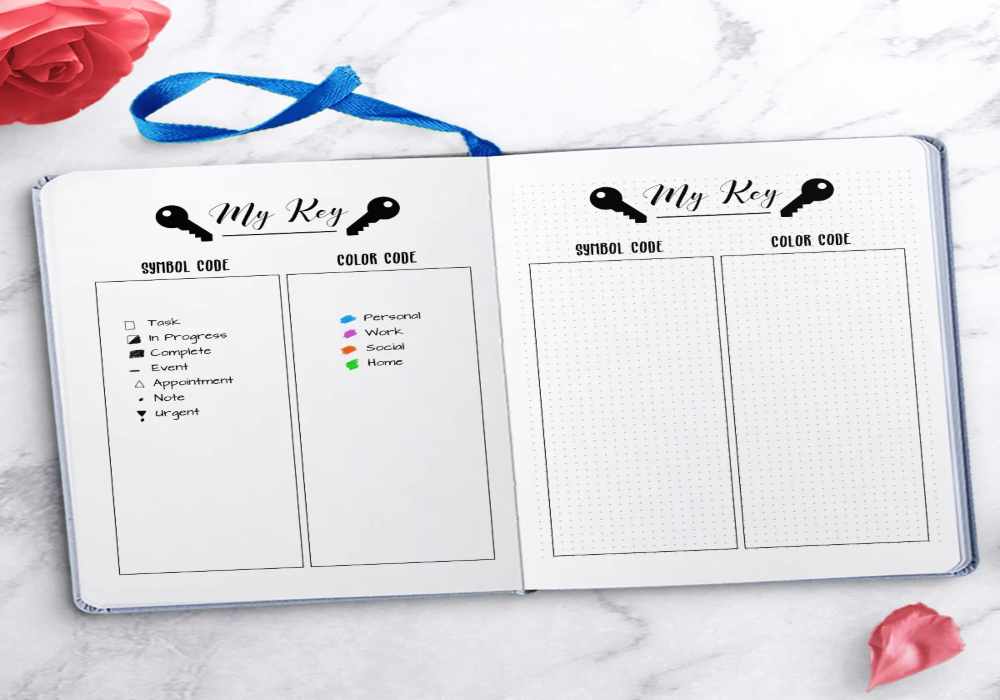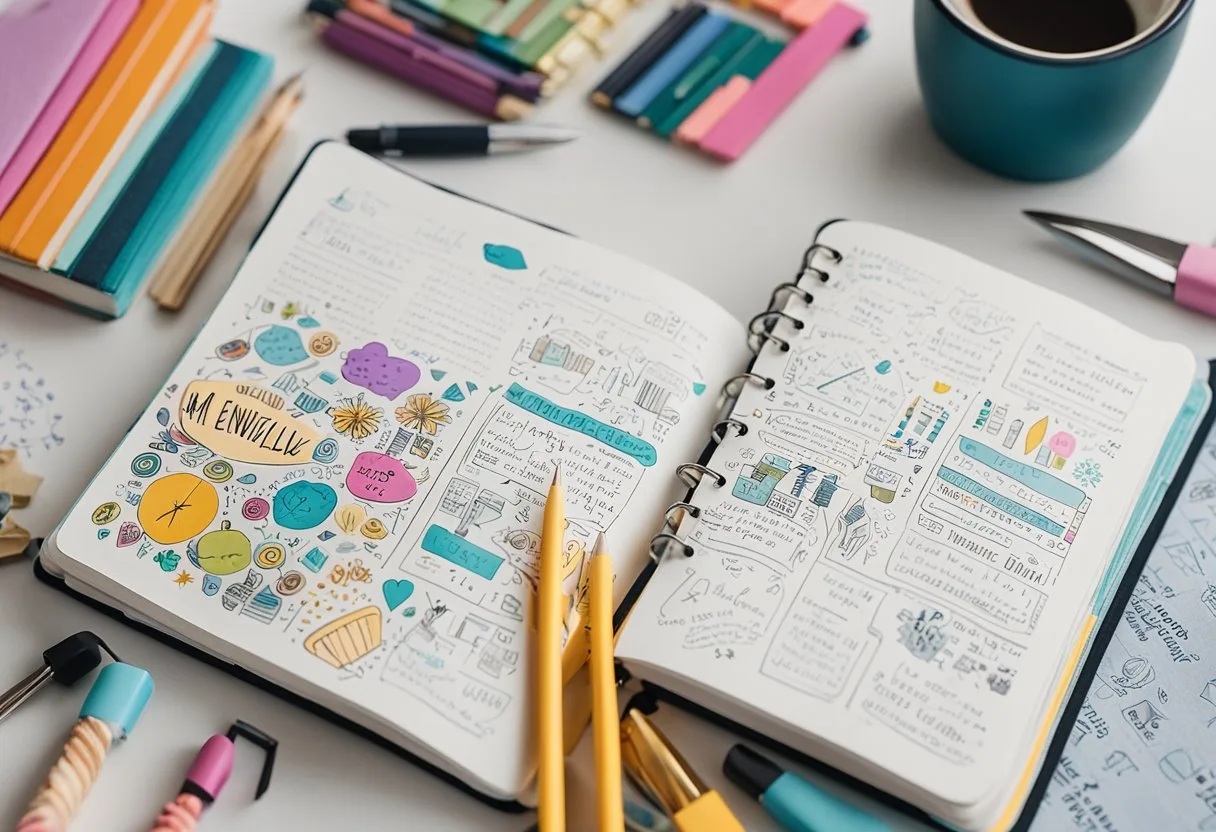Journaling is a highly recommended stress-management tool that can help reduce anxiety and increase well-being. Evidence suggests that journaling can be a useful strategy to help combat anxiety, reduce stress, and support mental health. A 2018 research study found that people who journaled had a reduction in symptoms of depression and anxiety. That’s because the process of writing can release pent-up feelings and emotions, allowing individuals to better understand and cope with their anxieties.
To start journaling for anxiety, it is important to set aside time each day to write down thoughts and emotions. It can be helpful to choose a specific time of day, such as first thing in the morning or before bed, to establish a routine. The act of writing down worries and concerns can help individuals gain a sense of control over their thoughts and feelings, reducing the sense of overwhelm that often accompanies anxiety. Journaling can provide a safe space to explore difficult emotions and gain insight into the underlying causes of anxiety.
Daily journaling can be a valuable tool for managing anxiety and improving mental health. By regularly expressing and processing emotions, individuals can gain a better understanding of their thoughts and feelings, leading to a greater sense of well-being.
Understanding Anxiety and Its Impact
Anxiety is a natural response to stress, and it can be beneficial in some situations. However, when anxiety becomes excessive or chronic, it can interfere with daily life and mental well-being.
Stress is a part of life, and it can be a motivator for some people. However, chronic stress can lead to negative emotions and mental health problems, including anxiety disorders. Anxiety can cause physical symptoms such as rapid heartbeat, sweating, and trembling, as well as negative thoughts and feelings of fear and worry.
Recognizing Anxiety Disorders and Symptoms
Anxiety disorders are a group of mental health conditions characterized by excessive, persistent, and irrational fear or worry. There are several types of anxiety disorders, including generalized anxiety disorder, panic disorder, social anxiety disorder, and specific phobias.
Symptoms of anxiety disorders can vary from person to person, but common symptoms include excessive worry, restlessness, fatigue, difficulty concentrating, irritability, muscle tension, and sleep disturbances. These symptoms can interfere with daily life and mental well-being, and it is essential to seek help from a mental health professional if they persist.
Understanding anxiety and its impact on mental well-being is crucial for anyone looking to manage anxiety symptoms. By recognizing the role of stress and anxiety in mental health, and recognizing anxiety disorders and symptoms, individuals can take steps to manage their anxiety and improve their overall well-being.
How to Journal Daily for Anxiety
Journaling can be a helpful tool for managing anxiety. It can provide an outlet for emotions, help identify triggers, and track progress. Here are some steps to get started with daily anxiety journaling:
- Set aside time each day: Schedule a specific time each day to write in your journal. This can help make journaling a habit and ensure that it doesn’t get forgotten.
- Find a quiet space: Choose a quiet, private space where you can focus on your thoughts and feelings without distractions.
- Write freely: Don’t worry about grammar, punctuation, or spelling. Write whatever comes to mind, even if it doesn’t make sense at first. This can help you get in touch with your emotions and thoughts.
- Be honest: Write honestly about your feelings, even if they are uncomfortable or unpleasant. This can help you identify triggers and patterns in your anxiety.
- Track progress: Keep track of your progress by noting any changes in your anxiety levels or triggers. This can help you identify what works and what doesn’t work for you.
Daily Journal Prompts For Anxiety
- What specific thoughts or situations triggered anxiety today?
- Identify three things you are grateful for despite feeling anxious.
- List three small accomplishments, no matter how minor, that you achieved today.
- Reflect on a recent challenging situation and explore what lessons can be learned from it.
- Describe one positive interaction or moment that brought comfort during the day.
- Write down three self-care activities you can prioritize to alleviate anxiety.
- Explore any recurring patterns in anxious thoughts and consider potential coping strategies.
- Identify one thing you can let go of or delegate to reduce daily stress.
- Reflect on your breathing patterns throughout the day and explore moments of tension.
- Write about a future goal and break it down into smaller, manageable steps.
- List three people or resources you can turn to for support during anxious moments.
- Document any moments of self-compassion or kindness you extended to yourself.
- Reflect on how you responded to stressors and consider healthier alternatives.
- Describe a favorite calming activity and plan to incorporate it into tomorrow’s routine.
- Identify any negative self-talk and reframe those thoughts in a more positive light.
- Write about a specific fear and explore realistic ways to confront or manage it.
- Document any instances of practicing mindfulness or being present in the moment.
- Consider setting realistic expectations for yourself and others to reduce pressure.
- Reflect on your sleep patterns and explore ways to improve the quality of your rest.
- Write about a past anxious moment that you successfully navigated and overcame.
- List three hobbies or activities that bring joy and consider scheduling them regularly.
- Document your daily stressors and categorize them as controllable or uncontrollable.
- Reflect on your support system and express gratitude for those who uplift and understand you.
- Write a letter to yourself, offering encouragement and reassurance during anxious times.
- Plan a specific action or step you can take tomorrow to proactively manage anxiety.
The Basics of Journaling for Anxiety
Journaling is an effective technique that can help alleviate anxiety symptoms. It is a simple and accessible way to manage anxiety that can be done anywhere and at any time. Here are some basic tips for starting a daily journaling practice:
Choosing the Right Journal
Choosing the right journal is essential for a successful journaling practice. A journal should be a place where one feels comfortable expressing their thoughts and feelings. It is important to choose a journal that is easy to use and has enough space to write freely. A small notebook or a blank journal can be an excellent choice for an anxiety journal. It is also important to choose a pen that is comfortable to write with and does not smudge.
Creating a Conducive Environment for Writing
Creating a conducive environment for writing can help one to focus and write freely. It is important to find a quiet and comfortable place to write where one can be free from distractions. One should also set aside a specific time each day for journaling to establish a routine. It is also helpful to create a ritual around journaling, such as lighting a candle or playing calming music.
Starting a daily journaling practice can be an effective way to manage anxiety symptoms. Choosing the right journal and creating a conducive environment for writing can help one to establish a successful journaling routine.
Journaling Techniques and Prompts
Journaling is a powerful tool for managing anxiety, and there are several techniques that can be used to make the most of this practice. Here are three effective journaling techniques and prompts to try:
Expressive Writing and Its Benefits
Expressive writing involves writing about your deepest thoughts and feelings, without worrying about grammar, spelling, or punctuation. This technique can help you gain insight into your emotions and experiences, and it has been shown to be effective in reducing anxiety and stress.
One way to get started with expressive writing is to write about a difficult experience you’ve had, and explore your feelings about it. For example, you might write about a recent argument with a friend or family member, and reflect on why it was so upsetting for you.
Structured Journaling for Clarity
Structured journaling involves using prompts or questions to guide your writing, and can be helpful if you’re feeling overwhelmed or unsure of where to start. By focusing on specific topics or themes, you can gain clarity and perspective on your thoughts and emotions.
One example of a structured journaling prompt is to write about your goals and aspirations. What do you want to achieve in your life, and why? What steps can you take to move closer to these goals? By exploring these questions in writing, you may gain a deeper understanding of your values and priorities.
Freewriting to Release Anxious Thoughts
Freewriting is a technique that involves writing continuously for a set period of time, without worrying about structure or coherence. This technique can be helpful for releasing anxious thoughts and feelings, and can be used as a daily practice to help manage anxiety.
To try freewriting, set a timer for 10-15 minutes, and start writing whatever comes to mind. Don’t worry about spelling, grammar, or punctuation, and don’t stop to edit or revise your work. The goal is simply to get your thoughts and feelings down on paper, and to release any pent-up emotions or stress.
Incorporating Mindfulness and CBT into Journaling
When it comes to journaling for anxiety, incorporating mindfulness practices and cognitive-behavioral therapy (CBT) techniques can be highly effective. Mindfulness is the practice of being present and fully engaged in the current moment, while CBT is a form of therapy that focuses on changing negative thought patterns and behaviors. By combining these two approaches with journaling, individuals can develop a deeper awareness of their thoughts and emotions, and learn how to manage them in a healthy way.
Mindfulness Practices and Awareness
One of the most effective ways to incorporate mindfulness into journaling is to start each session with a brief mindfulness practice. This can be as simple as taking a few deep breaths and focusing on the physical sensations of the breath entering and leaving the body. By doing this, individuals can bring their attention fully into the present moment and set the stage for a more focused and productive journaling session.
Another way to practice mindfulness during journaling is to focus on the physical sensations in the body. This can involve paying attention to any tension or discomfort, as well as any areas of the body that feel relaxed and comfortable. By bringing awareness to these physical sensations, individuals can gain a deeper understanding of how their thoughts and emotions are impacting their physical well-being.
Cognitive Behavioral Therapy Techniques
CBT techniques can also be highly effective when incorporated into journaling. One technique involves identifying and challenging negative thought patterns. This can be done by writing down any negative thoughts that arise during the day, and then examining them more closely to determine if they are based in reality or if they are distorted in some way. Once these thoughts have been identified, individuals can work on challenging them and replacing them with more positive and realistic thoughts.
Another CBT technique that can be incorporated into journaling is behavioral activation. This involves identifying activities that bring joy and a sense of accomplishment, and then scheduling them into the day. By doing this, individuals can increase their overall sense of well-being and reduce feelings of anxiety and depression.
Incorporating mindfulness practices and CBT techniques into journaling can be a powerful tool for managing anxiety. By developing a deeper awareness of thoughts and emotions, and learning how to manage them in a healthy way, individuals can improve their overall well-being and reduce feelings of anxiety and stress.
Building a Daily Journaling Habit
Developing a daily journaling habit can be an effective way to manage anxiety. By setting a regular schedule and tracking progress, individuals can establish a routine that fosters growth and reflection.
Setting a Regular Schedule
Establishing a consistent time to journal each day can help build a habit. It is recommended to choose a time that works best for the individual’s schedule and stick to it. Some individuals prefer to journal in the morning, while others find it helpful to journal before bed. Whatever time is chosen, it is important to make it a priority and commit to it.
Tracking Progress and Reflecting on Growth
Keeping track of progress and reflecting on growth can help individuals stay motivated and continue their journaling habit. One way to track progress is to create a journaling plan or routine. This can include setting goals, such as journaling for a certain amount of time each day or focusing on specific topics. By tracking progress, individuals can see their growth and identify areas for improvement.
Reflection is also an important part of building a daily journaling habit. By reflecting on what has been written, individuals can gain insight into their thoughts and emotions. This can help them better understand their anxiety and identify patterns or triggers. Reflection can also help individuals celebrate their progress and recognize their achievements.
Building a daily journaling habit can be a powerful tool for managing anxiety. By setting a regular schedule and tracking progress, individuals can establish a routine that fosters growth and reflection.
Frequently Asked Questions
What are effective journaling techniques for managing anxiety?
Journaling is a highly recommended tool for managing anxiety. Effective journaling techniques include writing about your feelings, thoughts, and experiences. It is also helpful to write about the positive things in your life, as well as your accomplishments and goals. Mindfulness journaling, where you focus on the present moment, can also be beneficial for managing anxiety.
Can positive affect journaling reduce anxiety symptoms?
Yes, positive affect journaling can reduce anxiety symptoms. This type of journaling involves writing about positive experiences, emotions, and thoughts. It can help shift your focus away from negative thoughts and emotions, which can contribute to anxiety. By focusing on positive experiences, you can increase your overall sense of well-being and reduce anxiety symptoms.
What role does journaling play in cognitive behavioral therapy for anxiety?
Journaling is an important component of cognitive behavioral therapy (CBT) for anxiety. It is used to identify negative thought patterns and behaviors that contribute to anxiety. By writing down your thoughts and feelings, you can gain insight into your triggers and develop strategies to manage them. Journaling also helps you track your progress and identify areas where you need to focus your attention.
How can keeping a worry journal help in coping with anxiety?
Keeping a worry journal can help in coping with anxiety by allowing you to identify and challenge your negative thoughts. By writing down your worries, you can examine them more objectively and develop strategies to manage them. Worry journaling can also help you develop a sense of control over your anxiety, as you learn to recognize and manage your triggers.
In what ways does journaling support mental health and alleviate depression?
Journaling supports mental health and alleviates depression by providing a safe space to express your thoughts and feelings. It can help you identify patterns and triggers that contribute to depression, and develop strategies to manage them. Journaling can help you focus on the positive aspects of your life, which can increase your overall sense of well-being.
What is the 3 3 3 rule and how can it be applied to journaling for anxiety relief?
The 3 3 3 rule is a technique for managing anxiety that involves focusing on three things you see, three things you hear, and three things you feel. This technique can be applied to journaling by writing about the three things you see, hear, and feel in your environment. This can help you shift your focus away from anxious thoughts and into the present moment.




